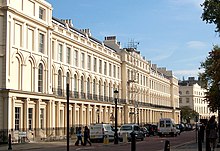
1 St Andrew's Place
(12 to 23) Park Square East
1 Albany Terrace
Park Square is a large garden square or private appendix to Regent's Park in London and is split from a further green, the long northern side of Park Crescent, by Marylebone Road and (single-entrance) Regent's Park tube station. It consists of two facing rows of large, very classically formed, stuccoed, terraced houses with decorative lower floor balconies and a colonnade of consecutive porticos by architect John Nash, and was built in 1823–24. Alike, shorter-length terraces flank its corners at right angles, equally Grade I listed buildings: Ulster Terrace, Ulster Place, St Andrew's Place and Albany Terrace.
Park Square Gardens at centre are private communal grounds for residents.[1] Fronting the north side is the traffic-calmed Outer Circle (road) of Regent's Park. The square is in the Marylebone historic parish addition to the City of Westminster save for the eastern side: in Camden (more particularly, its dominant Saint Pancras historic parish).[2]
On the east side of the square was Britain's first and longest-lasting of four national exhibitions of the Diorama, the building of which remains, in other use – it opened from 1823 until 1852. North-east beyond much smaller St Andrews Place, about twice the Diorama's size, was London Colosseum, built for the largest painting ever made and which was demolished in 1874 – both had large foyers and attracted many visitors.
Unusually it has eight buildings within it, omitting which space, the garden added to east and west sides' roads and footways spans 2.5 hectares (6.2 acres);[1] and the span is 218 metres between the two built-up sides. The gardens are owned by the Crown Estate which keeps four of the internal buildings. It opens to the public a few times per year for London Gardens Squares Weekends.[3] It is dominated by plane trees. The first set were planted in 1817 to celebrate the peace won by the Battle of Waterloo in 1815. Also of interest is a tulip tree, Liriodendron tulipifera.
- ^ a b Park Square NW1 Archived 2018-03-02 at the Wayback Machine, Open Garden Squares.
- ^ Park Square East, LondonTown.com.
- ^ London Gardens Online - details of frequency of participation in London Garden Squares Weekends.
